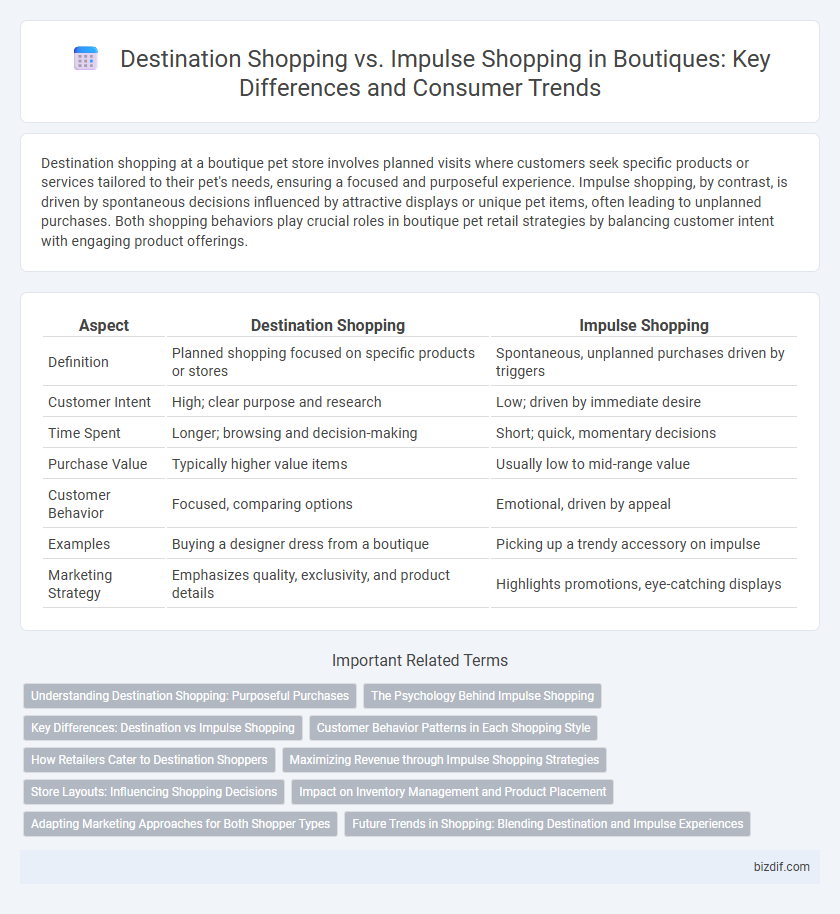Destination shopping at a boutique pet store involves planned visits where customers seek specific products or services tailored to their pet's needs, ensuring a focused and purposeful experience. Impulse shopping, by contrast, is driven by spontaneous decisions influenced by attractive displays or unique pet items, often leading to unplanned purchases. Both shopping behaviors play crucial roles in boutique pet retail strategies by balancing customer intent with engaging product offerings.
Table of Comparison
| Aspect | Destination Shopping | Impulse Shopping |
|---|---|---|
| Definition | Planned shopping focused on specific products or stores | Spontaneous, unplanned purchases driven by triggers |
| Customer Intent | High; clear purpose and research | Low; driven by immediate desire |
| Time Spent | Longer; browsing and decision-making | Short; quick, momentary decisions |
| Purchase Value | Typically higher value items | Usually low to mid-range value |
| Customer Behavior | Focused, comparing options | Emotional, driven by appeal |
| Examples | Buying a designer dress from a boutique | Picking up a trendy accessory on impulse |
| Marketing Strategy | Emphasizes quality, exclusivity, and product details | Highlights promotions, eye-catching displays |
Understanding Destination Shopping: Purposeful Purchases
Destination shopping targets consumers planning specific purchases, often seeking unique or high-quality items from boutiques. This intentional approach drives foot traffic to specialized stores, emphasizing product expertise and curated selections that meet well-defined customer needs. Retailers optimize inventory and store layout to enhance the purposeful shopping experience, encouraging higher satisfaction and loyalty.
The Psychology Behind Impulse Shopping
Impulse shopping in boutiques is driven by emotional triggers such as novelty, scarcity, and instant gratification, which activate the brain's reward system and release dopamine. Unlike destination shopping, where consumers follow a planned list, impulse shoppers respond spontaneously to sensory cues like attractive displays, enticing scents, and personalized service. Understanding these psychological mechanisms helps boutiques strategically design their environments to boost unplanned purchases and increase overall sales.
Key Differences: Destination vs Impulse Shopping
Destination shopping involves planned visits to boutiques where customers seek specific products, prioritizing quality and brand reputation. Impulse shopping at boutiques often occurs unexpectedly, driven by spontaneous desires triggered by appealing displays or promotions. The key difference lies in the shopper's intent, with destination shopping focused on deliberate choices and impulse shopping influenced by immediate emotions and environment.
Customer Behavior Patterns in Each Shopping Style
Destination shopping involves deliberate planning where customers seek specific products or brands, often resulting in longer visits and higher spending in boutique stores. Impulse shopping is characterized by spontaneous purchases driven by emotional triggers and attractive displays, prompting quick decision-making among boutique visitors. Understanding these distinct customer behavior patterns enables boutiques to tailor store layout, inventory, and marketing strategies to effectively capture both intentional and impulsive buyers.
How Retailers Cater to Destination Shoppers
Retailers cater to destination shoppers by creating immersive, personalized boutique experiences that emphasize exclusive product selections and expert customer service, encouraging planned visits. Strategically designed store layouts and unique in-store events foster a sense of discovery and brand loyalty, differentiating the boutique from standard retail outlets. Leveraging digital tools like appointment bookings and personalized recommendations enhances the convenience and exclusivity sought by destination shoppers, promoting repeat visits.
Maximizing Revenue through Impulse Shopping Strategies
Impulse shopping in boutiques significantly boosts revenue by encouraging spontaneous purchases through strategic product placement and appealing visual merchandising. Utilizing limited-time offers, eye-catching displays, and complementary product groupings maximizes average transaction value and increases customer engagement. Leveraging data analytics to identify peak shopping moments enables tailored promotions that effectively trigger impulse buys, driving higher sales performance.
Store Layouts: Influencing Shopping Decisions
Boutique store layouts designed with destination shopping in mind often feature curated, spacious displays that guide customers to specific product categories, enhancing intentional purchases. In contrast, impulse shopping layouts use strategically placed, eye-catching items near checkouts or high-traffic areas to encourage spontaneous buying decisions. Effective store design leverages lighting, signage, and product arrangement to influence customer flow and maximize sales.
Impact on Inventory Management and Product Placement
Destination shopping drives predictable inventory demand, enabling boutiques to stock high-margin, signature products prominently, optimizing shelf space for planned purchases. Impulse shopping requires strategic product placement near checkout areas and in highly visible spots to encourage spontaneous buys, necessitating flexible inventory levels for fast-moving, low-cost items. Balancing both shopping behaviors enhances inventory turnover and maximizes sales by aligning stock with consumer buying patterns.
Adapting Marketing Approaches for Both Shopper Types
Destination shopping requires boutiques to emphasize curated, unique product selections and personalized experiences, attracting customers who plan their visits. Impulse shopping demands strategic placement of eye-catching displays and limited-time offers that encourage spontaneous purchases. Adapting marketing by combining targeted promotions with in-store engagement maximizes customer satisfaction and sales across both shopper types.
Future Trends in Shopping: Blending Destination and Impulse Experiences
Future trends in boutique shopping emphasize a seamless blend of destination and impulse experiences, integrating immersive environments that encourage both planned visits and spontaneous purchases. Advanced technologies such as augmented reality and personalized recommendations enhance customer engagement by creating interactive, memorable shopping journeys. Retailers focus on curating exclusive products and unique atmospheres that transform boutiques into experiential hubs, driving higher conversion rates and customer loyalty.
Destination Shopping vs Impulse Shopping Infographic

 bizdif.com
bizdif.com